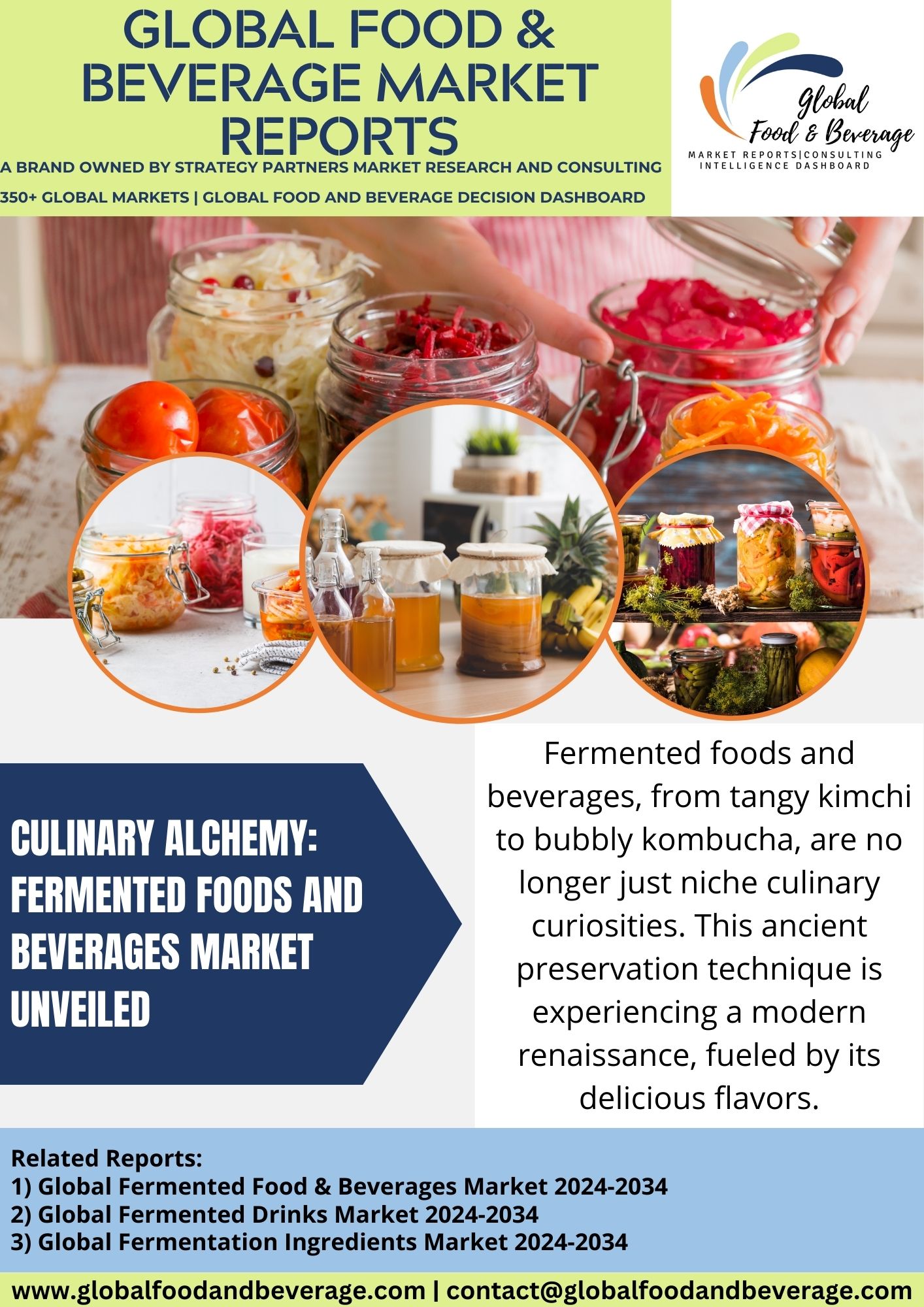Fermented foods and beverages have a rich history spanning cultures and centuries, and they play a significant role in both culinary traditions and nutritional practices worldwide. The process of fermentation involves the transformation of food or beverages by microorganisms, such as bacteria, yeast, or molds, leading to changes in flavor, texture, and nutritional composition.

One of the key benefits of fermented foods lies in their enhancement of flavor and palatability. The fermentation process often imparts unique and complex flavors to the original ingredients. Examples include the tangy taste of sauerkraut, the umami richness of soy sauce, and the effervescence of kombucha. These distinct flavors contribute to the culinary diversity and enjoyment of fermented products across various cuisines.
Beyond taste, fermentation has notable effects on the nutritional profile of foods. During fermentation, microorganisms break down complex compounds, such as sugars and starches, into simpler forms, making nutrients more bioavailable. Additionally, the presence of beneficial microorganisms in fermented foods, often in the form of probiotics, can have positive effects on gut health. Yogurt, kefir, and kimchi are examples of fermented foods known for their probiotic content, promoting a healthy balance of gut microbiota.
Fermentation also acts as a natural preservation method, extending the shelf life of perishable foods. Historically, fermentation played a crucial role in food preservation before the advent of modern refrigeration techniques. The preservation aspect allows communities to store and consume seasonal produce throughout the year, contributing to food security and sustainability.
The popularity of fermented foods and beverages has surged in recent years, driven by a growing interest in probiotics, gut health, and diverse culinary experiences. Products like kombucha, miso, tempeh, and artisanal sourdough bread have become staples in modern diets, reflecting a shift towards recognizing the value of traditional and artisanal food preparation methods.
Fermented foods are not limited to one culture or region; they are found in various forms across the globe. From the Korean staple kimchi to the German sauerkraut, and from the Middle Eastern labneh to the Japanese miso, fermented foods showcase the universality of this ancient culinary practice.
ADVANCEMENTS
Fermented foods and beverages showcase a revival and expansion of traditional food preservation and preparation methods, driven by the recognition of their numerous health benefits and unique flavors. One significant breakthrough is the application of precision fermentation in the production of fermented foods. Precision fermentation involves using microbial cultures to produce specific compounds, flavors, or nutrients in a controlled and scalable manner. This technology allows for the creation of customized fermented products with enhanced nutritional profiles and consistent quality.
The exploration of diverse and novel fermentation substrates has expanded the range of fermented foods available. Innovations include fermenting non-traditional ingredients like seaweed, plant-based proteins, and alternative grains, catering to evolving dietary preferences and providing unique taste experiences.
Advancements in probiotic research have led to the development of fermented foods with enhanced health-promoting properties. Probiotic strains, such as Lactobacillus and Bifidobacterium, are carefully selected and incorporated into various fermented products to support gut health, immune function, and overall well-being.
The integration of automation and artificial intelligence in fermentation processes has optimized production efficiency and quality control. Smart fermentation systems monitor and adjust variables in real time, ensuring consistent product quality and reducing the risk of batch-to-batch variations.
The fermentation of beverages, beyond traditional options like beer and wine, has seen notable innovation. Kombucha, kefir, and other fermented beverages have gained popularity due to their probiotic content and unique flavor profiles. Additionally, the introduction of alcoholic beverages fermented from non-traditional sources, such as hard seltzers and fruit-based alcoholic drinks, reflects the industry’s response to changing consumer preferences.
CHALLENGES
The production and consumption of fermented foods and beverages come with various challenges, ranging from production processes to consumer perception and market dynamics. One significant challenge is ensuring consistent product quality. Fermentation is a biological process influenced by various factors, including microbial activity, temperature, and raw material quality. Maintaining consistency in flavor, texture, and safety poses a continuous challenge for producers, necessitating robust quality control measures.
Contamination and spoilage during fermentation are persistent challenges. Unwanted microorganisms can compromise the fermentation process, leading to off-flavors or safety concerns. Implementing strict hygiene practices, monitoring microbial populations, and ensuring the use of high-quality raw materials are essential to mitigate these risks.
Scaling up production while maintaining the artisanal qualities of fermented foods is a challenge for many producers. Balancing increased demand with the need for traditional fermentation methods and small-scale production can be intricate. Producers must carefully manage this growth to ensure product integrity and meet market demand without compromising quality.
Regulatory compliance is a significant challenge in the fermented foods and beverages industry. Adhering to food safety standards, labeling requirements, and navigating diverse regulations across regions or countries demand continuous diligence. Meeting these standards is crucial for ensuring consumer safety and facilitating market access.
Consumer perception and education play a role in the challenges faced by the industry. While fermented foods offer numerous health benefits, consumer understanding of these benefits and acceptance of diverse flavors can vary. Effectively communicating the positive aspects of fermentation and addressing potential misconceptions are ongoing challenges for industry stakeholders.
Market competition is intense, with a growing number of artisanal and commercial producers entering the fermented foods and beverages space. Standing out in a crowded market requires differentiation, innovation, and effective marketing strategies.
CONCLUSION
Fermented foods and beverages stand as timeless alchemies of tradition and nutrition, enriching culinary landscapes across cultures. From tangy kimchi to probiotic-rich kombucha, these creations not only tantalize taste buds but also promote gut health and overall well-being. As global interest in digestive wellness and diverse flavors rises, fermented products are experiencing a renaissance. The symbiotic dance of microorganisms and substrates mirrors the synergy between ancient wisdom and modern science. The future of fermented foods promises a flavorful journey where tradition, innovation, and health-conscious choices converge, offering a holistic and delicious approach to nourishing the body and delighting the palate.
